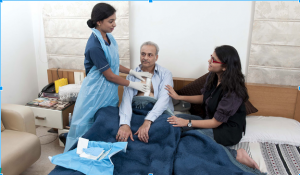
Taking care of a terminally ill patient at home is no longer a challenge. Earlier healthcare at home was restricted to nursing care and physiotherapy. However, these days technology and portable healthcare equipment have changed the game altogether and have made it possible to provide palliative healthcare for the elderly. So, if you are taking care of a critically unwell patient at home needing ICU services, with the help of technology and portable equipment it is possible to set up an ICU at home. Thus, you are able to get specialised medical care within the comfort of your home without visiting the overcrowded hospitals.
For critically unwell patients, health care at home spares them the agony of prolonged commute and enduring expensive medical bills. In the past few years, the cost of medical care has grown up exponentially as there has been an increase in chronic diseases such as diabetes, chronic obstructive pulmonary disease, chronic artery diseases and stroke. Couple it with increased life expectancy, taking care of a dying parent becomes an emotional and financial burden. Healthcare at home makes it easier for the family members as they don’t have to shuttle between the hospital and home.
Know your home-healthcare equipment
While setting up health care at home service for your family member, do keep in mind that standard ICU equipment, a bed with a special mattress, monitors, bi-pap machine, portable diagnostic machines, defibrillator and oxygen concentrator can be installed at home and you have the option to buy them new or used.
1. Oxygen concentrator/Portable Oxygen Concentrator
It is a device that helps patients with low-level of oxygen in the blood. A wide variety of oxygen concentrators are available with different features, which is powered by plugging it into electrical outlets and another one is battery powered portable oxygen concentrators. Oxygen concentrator can be easily carried anywhere, wherever a person travels, it can also be taken to aeroplanes. The compressor in the oxygen concentrator compresses air which gets filtered into the concentrator and then delivers the air in a continuous stream.
.
- Pulse Oximeter
Pulse Oximeter is a device for monitoring the blood oxygen level in a person. This device is applied to a thin part of a person’s body part such as earlobe, fingertip or across the foot.
- Finger Tip Pulse Oximeter
Finger Pulse Oximeter is placed on a fingertip of patients to read oxygen saturation level.
- Tabletop pulse oximeter
A tabletop pulse oximeter is portable in nature and one that can be placed on the table next to the patient bed. The tabletop pulse oximeter includes SpO2 values, pulse rate and the plethysmographic waveform of the patient.
- ECG machine
It records the heart activities over a period through the use of electrodes that are placed on the skin. ECG helps in diagnosing abnormalities of the heart such as enlargement of chambers or abnormal electrical activity in the heart.
.
- Multipara monitor/Patient Monitor/ETCO2 monitor
Multipara monitor is also known as patient monitor and It is used to monitor medical parameters associated with any diseases or conditions over time. Multipara monitor also includes in checking blood pressure, respiratory rate and heart rate.
- Syringe pump
It uses a small pump which infuses a small quantity of fluids, or nutrients into a patient.
6. Holter monitoring/ Ambulatory electrocardiography
It is a battery-powered portable device that records and measures the heart activity. It consists of a wire with a small electrode which is attached on the skin for reading the heart activity.
7.Ventilator
A medical ventilator is a machine that delivers breathable air into and out of the lungs. It is used for patients who face difficulties in breathing. It consists of a tube which is connected to the patient’s windpipe and this breathing tube passes air and oxygen into the lungs.
Noninvasive ventilator provides patients with breathing support through either mask or nasal prongs. The advantage of this ventilator is it reduces the risk of lung damage which occurs from inspiratory pressures.
The patients who are on long term ventilation require intense care need invasive ventilators in which a tube is inserted into the patient’s mouth or nose. This tube delivers air and it is adjusted according to the patient’s requirement.
Setting up home care services like a hospital for a loved one, you need to buy equipment that will help monitor oxygen concentration in the blood of the patients, the pace of their heartbeat, as well as the functioning of their lungs. If you are looking for quality hospital equipment whether new, used or refurbished visit www.primedeq.com
To discover latest Indian blogs

![]()
